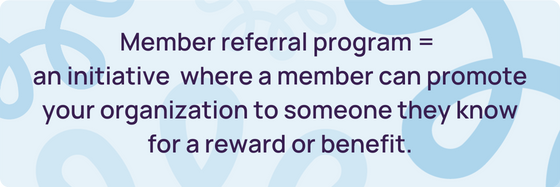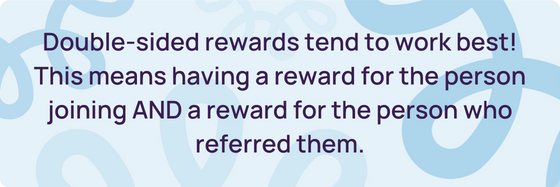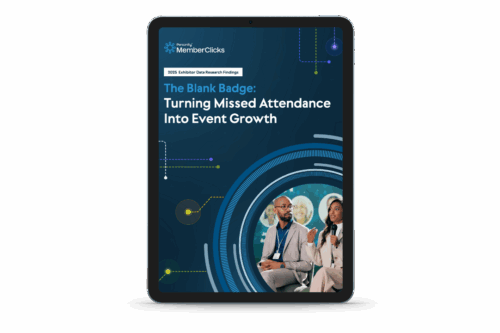Growing your organization is no easy feat. You probably do some email marketing, event marketing (to attract potential prospects) and maybe even some inbound marketing. But are you tapping into your strongest marketing tool – your members? This is where referral programs can make a big difference.
A referral program is one of the best ways to recruit new members. Potential members are much more likely to join when they hear how awesome your organization is from their peers — and, having your happiest and most engaged members talking you up is a surefire way to welcome new members who are excited and ready to engage.
Don’t believe us? Then listen to the stats.
Referral marketing statistics that will blow your mind
92% of customers trust referrals that are made from people they know.
A member who is referred has a lifetime value that is 16% higher than a non-referred member.
Referral members are 30% more likely to actually join.
69% of customers who had a positive experience with a company would recommend the brand to other people.
Referred customers have a 37% higher retention rate compared to other customers gained through other marketing channels.
For every 1 happy customer, you also get 9 referrals.
Thanks to Finance Online and Review 42 for these stats.
Referral programs VS referral marketing
In essence, these two terms are different sides of the same coin.
A referral program is the actual process you put in place that allows one member to suggest joining to another and get something from it. Referral marketing is about using the relationships of your members to grow your organization numbers, expand awareness of your organization and also how you share your program out to members.
In reality, one can’t exist without the other and the two are often used in conjunction.
What exactly is a member referral program?
A member referral program is an initiative you build where a member can promote your organization to someone they know for a reward or benefit. In a good referral program, both the referee and referer receive a bonus or benefit of some kind if the referee joins.

Who benefits from a referral program?
A referral program is a win-win-win situation.
Your current member wins because they get to 1) have someone they know join your association or chamber and enjoy the benefits you offer with and 2) get whatever bonus or benefit for successfully referring someone.
The referee / your new member wins because they 1) get a bonus or benefit for joining and 2) become a part of a group that can offer them a lot of benefits (your normal member benefits!).
Finally, you win because you have a new member! And that’s what member organizations are all about.
Why do they work?
As we explored in the stats above, referral programs work because people trust a first-person experience, especially when it’s coming from someone they know and trust. Even with a benefit or bonus to entice people to refer friends, it’s uncommon for someone to support an organization to a loved one if they really don’t mean it.
This is why memberships brought in through referral programs have such a high return. They really are the best quality potential member you can get.
Building a member referral program
There are a few steps you need to follow when building a member referral plan.
1. Identify who you’re targeting
2. Determine what the incentives will be offered to both referees and referrers
3. Set rules
4. Set up your program
5. Promote it
Let’s break these down.
1. Identify who you’re targeting
Before creating a member referral program, you need to decide you main goal with the plan.
Are you trying to recruit all types of members (student, associate, organizational, etc.)? Or are there specific member types you’re hoping to boost (professionals, specific organizations, etc).
The type of member – or who you’re targeting – will affect everything else you build into this program. This step can make or break your program so don’t rush it.
At the same time, don’t overthink it! If you want to boost members, period, don’t worry about being too general. There’s nothing wrong with running a general referral plan if numbers are your goal.
Take some time thinking this over before hashing out the rest.
2. Determine what the incentives will be offered to both referees and referrers
Once you know who you’re trying to target, spend some time thinking about what the incentives will be.

As far as what the reward should be, that’s completely up to you. If you can offer some kind of financial discount (on membership, a trade show, etc.), that’s great. But if not, consider offering something else – a free webinar or a free book/industry report. Just know that the better the incentive, the more effective your program is likely to be.
Keep in mind, too, that an incentive can look different to different types of people. Professional members may value one-on-one time with a leader in your organization. Maybe it’s tickets to a networking event, or something else that they specifically would love. Get crafty!
3. Set rules
You may want your program to run on and on forever and ever, or you may want to add a deadline to it. You may want to have it be a “join and you win!” type of program, or maybe the new member needs to stay for at least 3 months.
There is no right and wrong to these “rules” but they all come down to your organization and what success looks like to you.
4. Set up your program
You can make your referral program as simple or as elaborate as you’d like. If you’re looking for something a little more full-fledged, consider seeking out referral program software, which will handle codes and tracking and all that for you.
But if you’re looking for something a little more simple and/or that type of software is out of your budget, don’t hesitate to set this up on your own. You can make it as simple as having a “Did someone refer you? If so, who?” section on your member application. Then, as those come in, you can reward the two members accordingly.
5. Promote it
Once you have your referral program set up, promote it! There are a few places you can promote it:
- Social media
- Announcement email
- General newsletter
- On your website
- In phone calls
When you’re promoting it, don’t forget to hone in on those incentives! That’s what’s going to get people to take action and get talking about your organization.
If you are hoping to target in on a specific type of member, use your member data reports to identify your most engaged members within that segment. Reach out to those people with a personalized email or (depending on the number) phone call. It can take more time but can ultimately be more successful.
Seasonal referral programs
If students are your target, or another group of people who usually operate on a cyclical cycle, you may want to promote your program at a specific time of year. They may be more willing to engage with your organization if they’re less busy, or more enticed with a member discount or bonus incentive when they’re in need of it.
Best practices and tips for running a member referral program
Be sure to say ‘thank you’ – Thank your member who referred them and the new member for joining. But especially the referrer. They did your organization a big favor, so show your appreciation. Make this note personal if possible. And be authentic with it.
Use your engaged members in other ways – If they’re already referring someone, maybe they’ll give you a quote about your organization you can use on your website! Your engaged members are not to be ignored.
Consider all new members as potential referrers – The likelihood of a member referring your association or chamber to someone they know begins the moment they sign up. How you treat your new members, their onboarding experience. . . all of it impacts how they speak about you. Keep that in mind from day 1.
Keep it simple – it can be easy to get caught up in a big complex referral plan with levels and compensation types. But complex isn’t always best. Referral programs are supposed to make it easier for you to get new members. Don’t make it more work than it needs to be.
Member referral programs: A powerful tool you already have
People love to talk about good experiences – especially when they get something out of it. Member referral programs are a great way to use your existing members to bring in new ones, with benefits for everyone!
Keep in mind that the best running programs exist with amazing organization. Focus on building something that your members can’t help but rave about and the referrals will follow. Before you know it, you’ll be scaling your organization and looking for new ways to engage with your members.

















